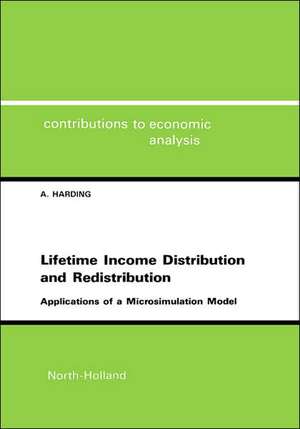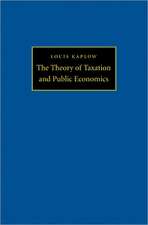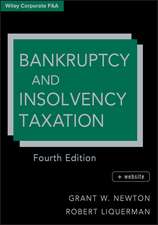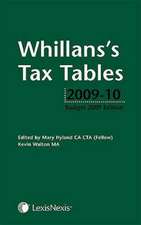Lifetime Income Distribution and Redistribution – Applications of a Microsimulation Model: Contributions to Economic Analysis
Autor A. F. Hardingen Limba Engleză Hardback – 13 oct 1993
Din seria Contributions to Economic Analysis
- 9%
 Preț: 802.42 lei
Preț: 802.42 lei - 23%
 Preț: 1071.35 lei
Preț: 1071.35 lei - 23%
 Preț: 1023.59 lei
Preț: 1023.59 lei - 23%
 Preț: 932.12 lei
Preț: 932.12 lei - 23%
 Preț: 1258.06 lei
Preț: 1258.06 lei - 23%
 Preț: 1125.47 lei
Preț: 1125.47 lei - 23%
 Preț: 1072.71 lei
Preț: 1072.71 lei - 23%
 Preț: 1134.25 lei
Preț: 1134.25 lei - 23%
 Preț: 1025.01 lei
Preț: 1025.01 lei - 23%
 Preț: 928.43 lei
Preț: 928.43 lei - 23%
 Preț: 1327.58 lei
Preț: 1327.58 lei - 23%
 Preț: 1090.22 lei
Preț: 1090.22 lei - 23%
 Preț: 1196.60 lei
Preț: 1196.60 lei - 23%
 Preț: 928.84 lei
Preț: 928.84 lei - 23%
 Preț: 1061.82 lei
Preț: 1061.82 lei - 23%
 Preț: 1113.58 lei
Preț: 1113.58 lei - 23%
 Preț: 874.46 lei
Preț: 874.46 lei - 19%
 Preț: 673.76 lei
Preț: 673.76 lei -
 Preț: 333.43 lei
Preț: 333.43 lei - 23%
 Preț: 1264.34 lei
Preț: 1264.34 lei - 23%
 Preț: 1323.45 lei
Preț: 1323.45 lei - 23%
 Preț: 1261.24 lei
Preț: 1261.24 lei - 23%
 Preț: 1099.44 lei
Preț: 1099.44 lei - 23%
 Preț: 1149.25 lei
Preț: 1149.25 lei - 23%
 Preț: 836.47 lei
Preț: 836.47 lei - 23%
 Preț: 854.99 lei
Preț: 854.99 lei - 23%
 Preț: 1125.37 lei
Preț: 1125.37 lei - 23%
 Preț: 932.57 lei
Preț: 932.57 lei - 23%
 Preț: 1018.90 lei
Preț: 1018.90 lei - 23%
 Preț: 1204.17 lei
Preț: 1204.17 lei - 23%
 Preț: 1398.42 lei
Preț: 1398.42 lei - 23%
 Preț: 1299.72 lei
Preț: 1299.72 lei - 23%
 Preț: 1221.55 lei
Preț: 1221.55 lei - 23%
 Preț: 1134.89 lei
Preț: 1134.89 lei - 23%
 Preț: 928.43 lei
Preț: 928.43 lei - 23%
 Preț: 930.35 lei
Preț: 930.35 lei - 23%
 Preț: 1028.12 lei
Preț: 1028.12 lei - 23%
 Preț: 895.88 lei
Preț: 895.88 lei - 23%
 Preț: 1096.14 lei
Preț: 1096.14 lei - 23%
 Preț: 999.71 lei
Preț: 999.71 lei - 23%
 Preț: 1052.38 lei
Preț: 1052.38 lei - 23%
 Preț: 1045.56 lei
Preț: 1045.56 lei - 23%
 Preț: 1255.61 lei
Preț: 1255.61 lei - 23%
 Preț: 1076.51 lei
Preț: 1076.51 lei - 23%
 Preț: 1042.59 lei
Preț: 1042.59 lei
Preț: 1266.20 lei
Preț vechi: 1644.42 lei
-23% Nou
Puncte Express: 1899
Preț estimativ în valută:
242.31€ • 263.12$ • 203.55£
242.31€ • 263.12$ • 203.55£
Carte tipărită la comandă
Livrare economică 22 aprilie-06 mai
Preluare comenzi: 021 569.72.76
Specificații
ISBN-13: 9780444898432
ISBN-10: 0444898433
Pagini: 436
Dimensiuni: 177 x 254 x 635 mm
Greutate: 0.97 kg
Editura: Emerald Publishing
Seria Contributions to Economic Analysis
ISBN-10: 0444898433
Pagini: 436
Dimensiuni: 177 x 254 x 635 mm
Greutate: 0.97 kg
Editura: Emerald Publishing
Seria Contributions to Economic Analysis
Cuprins
Preface. LIFETIME INCOME AND MICROSIMULATION MODELS. Introduction. Simulating longitudinal data. Outline of this book. Microsimulation Models. Types of microsimulation models. Problems of dynamic microsimulation models. Key Characteristics of the Model. Simulating the impact of government. Limitations of the model. Income and tax measures used in the model. LIFETIME RESULTS. Lifetime Income by Education, Family Status, and Unemployment Status. Lifetime income by education status. Lifetime income by familty status. Lifetime income by unemployment status. The Distribution of Lifetime Income. Lifetime income distribution of males. Lifetime income distribution of females. Income sharing within the family. Lifetime income for the entire cohort. Lifetime vs Annual Income Distribution and Redistribution. Annual income distribution by sex. Lifetime vs annual distribution. Lifetime vs annual tax-transfer incidence. Cash transfers and adjusted income taxes. Lifetime vs annual incidence of education. Lifecycle Income Distribution and Redistribution. Lifecycle income by lifetime income. Lifecycle income by lifetime family status. Lifecycle income by lifetime education status. Construction of the Model. The Demographic, Disability and Education Modules. Mortality. Disability, handicap and invalidity. Primary and secondary schooling. Tertiary education. Family formation and dissolution. Fertility. Labour Force Participation and Unemployment. Overview of the module. Labour force participation. Self-employment status. Full and part-time status and annual hours worked. Unemployment status and hours unemployed. Full-time students and invalids. Labour force profiles of the cohort. Earned and Unearned Income. Simulating earnings. Investment income. Superannuation income. Maintenance income. Government Expenditures and Taxes. Social security outlays. Education outlays. Income tax. Conclusion. Lifetime vs annual income distribution. Lifetime vs annual tax-transfer incidence. Intra vs inter-personal income redistribution. Relative position of men and women. Lifetime income by education. Lifetime income by family status. Appendix 1: The 1986 Australian Income Distribution Survey. Endnotes. References. Author index. Subject index.
Recenzii
... a very good book that moves us further along in our understanding of what such a distribution would look like and how taxation policies and income support policies can alter them.
I recommend this book to anyone interested in questions of income distribution and redistribution.
Journal of Economic Literature
I recommend this book to anyone interested in questions of income distribution and redistribution.
Journal of Economic Literature










